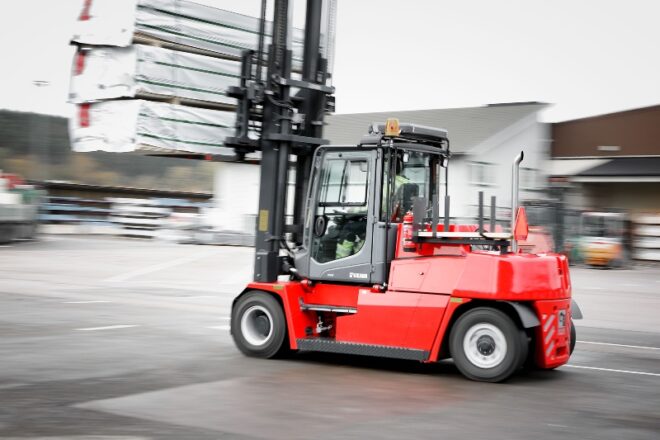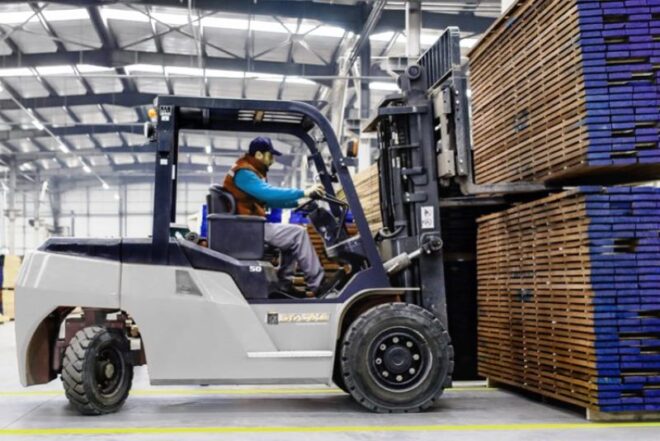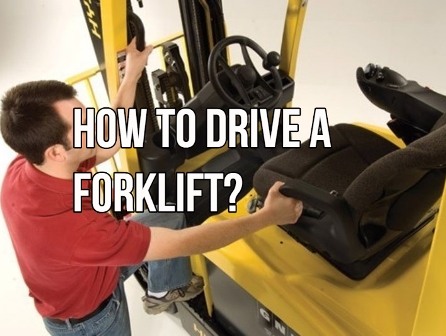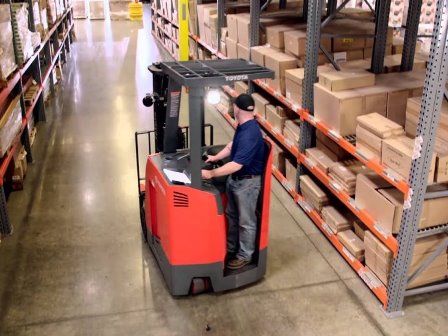When Traveling with a Load the Load Should be Lifted?
To handle a load safely, a forklift operator must consider dangers ranging from improper load weights to blind spots and hazards on the ground.
When lifting, moving or lowering a load with a forklift, smooth operation is essential for maintaining stability. This safety training aid looks at the correct way to load, carry, and unload when operating a forklift.

Forklift traveling with a load
When traveling with a load, always make sure to tilt the mast of the forklift backward so that the load will firmly place against the backrest to make it more secure during transport. By doing this, you move the center of gravity towards to rear of the forklift making it more secure when traveling.
Forklift loading:
- Fasten your seat belt.
- Make sure the load is within the forklift’s rated capacity. The nameplate on the forklift lists its maximum load weight. Never exceed it!
- Use the proper lift fixture for the type of loads, such as a carpet spike or drum grappler.
- Make sure the load is stable and centered; stack or tie uneven or loose loads.
- Spread the forks as wide as possible for even distribution and load stability.
- Approach the load squarely, positioning and inserting the forks far enough to be sure the pallet is completely on the forks. Take care not to damage materials stacked next to the pallet.
- Drive under the load until it touches the carriage. Tilt the forks back to shift the weight of the load and make it more stable.
- If the load is unbalanced, keep the heavier end closer to you. Tilt the mast back.
- Lift the load and tilt it back a little more before traveling.

Forklift carrying loads
As more forklift options and attachments become available, it is increasingly important for forklift operators to have a clear understanding of their forklift’s load capacity and the risks that are involved in exceeding it.
Forklift: Carrying the load
- Keep the forks 6 to 10 inches above the ground to avoid potential hazards on the ground.
- Remember that forklifts are top-heavy. Carry the load low and tilted back.
- Use caution when carrying a load on an uneven surface; it creates a tip-over hazard.
- Don’t carry anything on the overhead guard.
- Travel in reverse if the load blocks your vision.
- Always look in the direction of travel.
- Keep your arms and legs inside the forklift.
- Never reach through the mast to adjust the load.
- Do not raise or lower the load while moving.
- Use a spotter if you don’t have a clear view.
- Exercise caution and adjust your driving and speed to current weather conditions, particularly on wet surfaces.
- Travel at a speed that will allow the forklift to be brought safely to a stop.
Loading and unloading trucks with forklift
To ensure truck loading and unloading operations are conducted safely, to eliminate the potential for injuries, particularly as a result of vehicle and human interaction.
The following are general loading and unloading procedures for trucks:
- Turn the forklift slowly into position, squaring it up to the drop-off location.
- If unloading onto a semi-truck and trailer:
- before driving in, visually inspect the inside of the trailer to ensure that the bed is in good condition and of adequate height to accommodate the forklift;
- make sure the trailer’s rear wheels are chocked, the parking brake is set, and the dock plate is down and secure;
- slowly drive-in, position the load, and tilt it forward until it is even with the surface of the unloading location;
- then lower the load and release it.
- If unloading onto a stack:
- position the forklift properly before lifting the forks;
- check for overhead clearance before raising the load;
- raise and position the load to the correct height – 2 inches above the stack;
- allow 2 to 3 inches of clearance at the sides and back of the load;
- move the load slowly into position;
- tilt the load forward, then lower it;
- level the forks so they are no longer tilted; and
- pull the forks back slowly.
- If unloading onto a trailer or onto a stack:
- before reversing, check the clearance behind you, sound the horn, and with the backup alarm sounding, back up slowly while looking over your shoulder; and
- once you are clear, stop the forklift and lower the forks as far as possible. On a flat floor, lower them until they are 2 to 5 inches above the floor. On rough terrain, lift the forks higher to accommodate uneven ground.

Loading trucks with forklift
Be aware of pinch points and crush hazards during the loading and unloading process. Keep hands away from cargo and truck trailer during loading and unloading and avoid touching the load with your hands while it is moving or suspended. Utilizing hands-free tools and tag lines for assisting load control is appropriate.
- Truck drivers are not to walk into the work area during cargo handling operations unless authorized by an employee;
- Truck drivers must stay in the safe zone, for example, next to the cab, until the load has been loaded or unloaded and/or the truck driver has been authorized to leave the safe zone by the KPA dogman or forklift operator;
- If trucks are required to reverse on port lands and/or the wharf then a spotter is required at all times during the reversing operation.
- Truck drivers to remain with their vehicles unless there is an operational requirement to do otherwise;
It is the responsibility of the truck driver to ensure that a spotter is in place. The spotter could be an employee, another truck driver, a competent vessel crew member.
Reversing alarms must be installed and in good working order on all trucks. In addition, it is recommended that truck trailers have reversing beepers.
Unloading trucks with forklift
Any loads or items placed on the wharf from a vessel or truck must be placed in a planned methodical way considering good housekeeping practices and well clear of the hazard line to maintain sufficient room for any mooring or unmooring that may arise.
No items are to be stored on or inside the hazard line. In addition, trucks must park away from the hazard line to ensure that the driver does not need to enter the hazard zone to exit/enter the cab unless a safety control is in place (i.e. PFD or safety rail in place).
Check that there is adequate overhead clearance before raising the load. This is especially true when high tiering or in a confined space like a truck trailer. There must be sufficient headroom under overhead installations, lights, pipes, sprinkler systems, etc.
The most read

How to drive a Forklift?
Forklift safety is of the utmost importance, and driving a forklift improperly presents various risks to both yourself and others, as well as your surroundings and the things you’re lifting.

How to operate a stand-up forklift?
Two main ways of operating a forklift exist. Operating while sitting down, and operating while standing up.
